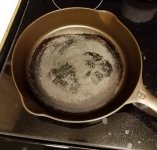DeLaneJenkins
New member
Hey guys, this is my first post. I've been following the site and several other cast iron sites for a while and trying to figure out things by reading and following the advice but I've finally come to the point I'm out of answers! I bought an old #8 griswold a couple of years ago to begin my collection for cooking. I stripped it down using Easy Off to bare metal. Scrubbed it with steel wool and soaked it in vinegar/water. It's a beautiful piece! After a ton of reading I decided to use the flax seed oil method by Sheryl Canter. I followed instructions to a T and spent a couple of days applying 6-7 coats. The skillet came out beautiful but in no time the seasoning began to flake. I stripped the pan again, followed the steps again and ended up with the same result not long after. I finally decided I was going to go with the tried and true method of crisco. I stripped the pan again, and followed the instructions on this website (http://www.castironcollector.com/seasoning.php) exactly and put on about 3 coats. Just to mention, I'm extremely meticulous when I do stuff and a stickler for every detail. Since then I have only cooked eggs a few times in the skillet, each time spraying it with the canola spray and cleaning it after with water only. I dry it, warm it back up in the oven to make sure it's completely dry, wipe it down with crisco again, wipe off the excess and let it cool in the oven. Tonight I decided I was going to do some cast iron burgers. I preheated the skillet to medium heat and threw a little dab of crisco in it because I was out of canola oil. It immediately started smoking and turning black so I used a paper towel in attempt to dab some of it up and to coat the skillet with the crisco. As I did, it looked like the seasoning was coming off completely down to bare metal. This picture shows what I ended up with. What am I doing wrong? Could it be the new crisco being primarily soybean oil instead of the old canola? If so should I switch to seasoning from the start with canola? Is there something else I could be doing wrong or missing? I'm assuming I'm going to have to strip the pan back down and start over. I don't know what else to do at this point!:headpop:
Attachments
Last edited:

